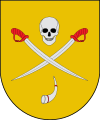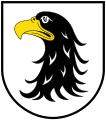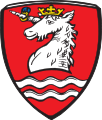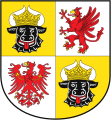Head (heraldry)
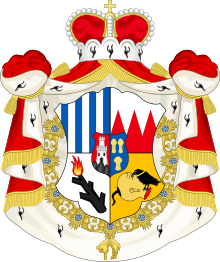
The head of the human or animal is in the Heraldry non-representation of a coat of arms figure . The coat of arms figure can be in the shield or in the upper coat of arms .
Human head
In the heraldic shield, the head in profile, looking heraldically to the right , is the normal position or looking at the viewer, i.e. en face. While the first type of representation in the description of the coat of arms is the head, the looking type is always only the face. Basically, the age and gender are indicated by hair or beard. The other necessary attributes, such as the headgear, indicate the rank or status. Many attributes have proven to be simple and unambiguous in the course of heraldic development. Women's heads are shown with flowing hair or pigtails.
The human head is only limited by a straight cut at the neck. Exceptions are the head of John , which is always shown in the bowl, and the Janus head , in which two faces are shown that look to both sides in the coat of arms.
Special heads of heraldry
- the argus head is a head covered with eyes
- the Janus head has two faces
- the gerion head has three faces
- there are donkey ears on the Midas head
- the head of Medusa has snakes instead of hair
- the angel or cherub head ( seraphin head )
List of attributes
- Farmer - hat
- Angel - wings on the head, cherub head
- Angel - headband with star
- Heath - heather hat
- Saint - nimbus
- Jew - Jew hat
- Young man - head bandage
- Virgo - long hair
- King -crown on male head
- Queen - crown on female head
- Elector - Elector Hat
- Mohrenkönig - Mohr with a crown
- Moorish head - black, earring and headband
- Fool cowl
- Fool - fool hat
- Pastor - wreath of hair
- Judge - Barrett
- Knight - visor helmet
- Devil's head - horns, dog-ears
- Skulls - also with wreaths or snakes twist
- Wild man - wreath of leaves on his head
- Widow - veil
Examples
Two Moor's heads
Seven heads ( Nurmijärvi )
speaking: Cheeks in the Allgäu
Angel head ( cherub head )
Medusa head in the coat of arms of Ferrières
Animal heads
All heraldic animals can only be with their heads in the coat of arms. A distinction must be made between a torn off and a cut head. Cut off means a straight cut through the neck, while torn off has a fluttering cut edge. In birds, the cut surface is covered with feathers, in mammals, scraps of skin are draped ( coat of arms of Mecklenburg ). These are often depicted in red for a bleeding cut. Animal heads can be crowned or raised with a crown. All variants are possible.
Examples
literature
- Walter Leonhard: The great book of heraldic art. Development, elements, motifs, design. License issue. Bechtermünz, Augsburg 2001, ISBN 3-8289-0768-7 , p. 175.
Individual evidence
- ↑ Ferdinand Biedenfeld: The heraldry or popular textbook of heraldry. Bernhard Friedrich Voigt, Weimar 1846, p. 36.







